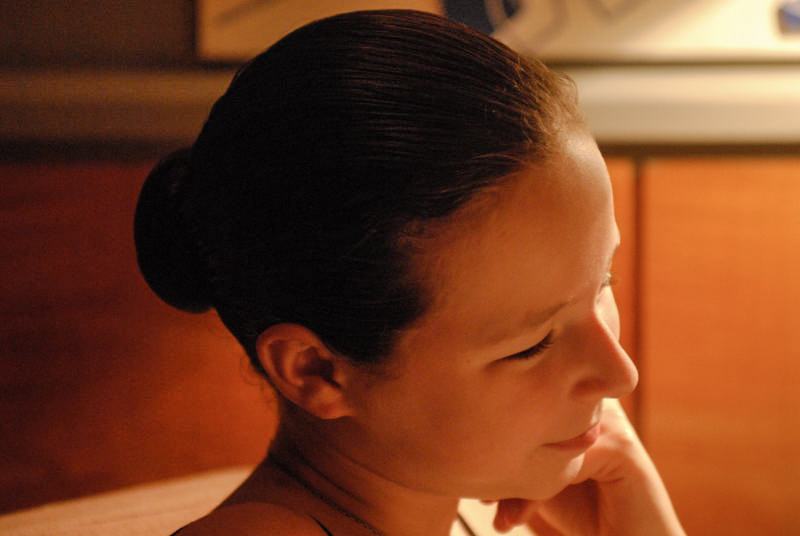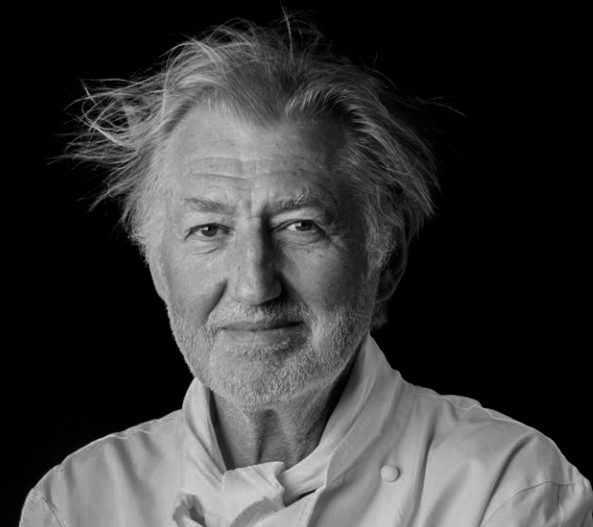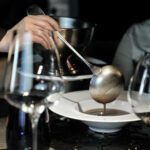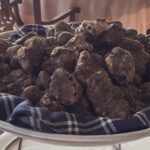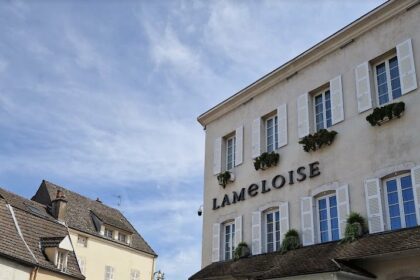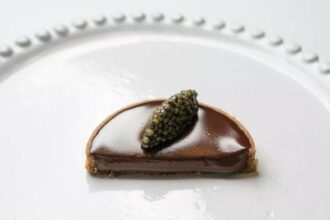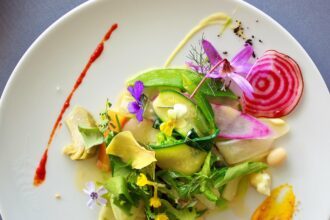A Pierre Gagnaire dish might be extremely cerebral at its initial conception and dangerously experimental during its development. Such a process may strike one as cunningly relying on accidental discoveries. One may also be tempted to qualify this practice as tainted by a self-absorbed, self approbating ego who presumes the fatality of circumstances will often bring about flavors he is entitled to, feeling certain that when that doesn’t happen his clientele should still be more than content to be able to take part in “his” adventure.
One would not have been far off but only if all ended there. It does not. The essential creative act in Gagnaire’s case undoubtedly operates at a higher level. It is almost palpable how he is guided by intuitions. Gagnaire’s decisions are not necessarily rational but deeply personal. They are forceful but contained. Impulsive but focused. Passionate yet contemplative, even introverted at times. Vulnerable.
When such artistic qualities are matched with a kitchen of extraordinary precision and techniques of great refinement the results are brilliant even if they are not always absolutely perfect. Sometimes the balance between the generosity and peripatetic proliferation of small plates may be quite off. Other times a compulsive rethinking of a dish that might have reached a very high level in a past season may make you wistful if not rather upset. Or, more sadly, some significant chemistry might be amiss when the Chef himself is not in the house.
Leaving aside the case where he might be physically absent, Gagnaire does not seem to mind a few imperfections in an attitude similar to that of the beloved Turkish poet Ece Ayhan who found unacceptable to make a small correction to a blatant error in a poem because it would be “a shame to disturb the beauty, once alive” or that of the great Vladimir Horowitz who did not mind engraving a few wrong notes for eternity even in his studio recordings:
I must tell you I take terrible risks. Because my playing is very clear, when I make a mistake you hear it. If you want me to play only the notes without any specific dynamics, I will never make one mistake. Never be afraid to dare.
A key to success with such poetic license is the ability to sense when it is time to stop experimenting, what needs to be cast off, what must be retained, when to destruct any impure growth and how to rebuild from scraps chasing an obscure ideal. Gagnaire is remarkably incisive in such manipulation of abstract spirit into discernible harmony.
Off the record, at these levels of virtuosity it is not very far fetched to expect a couple of miraculous flavors to spring into existence out of thin air either.
There are of course times when most of the stars align and others when disappointments may occur. Luckily for us, the dinner described below registered with the former. I believe we also helped it to some extent by passing over the tasting menu and choosing à la carte instead.
I find leaning for this option very natural, quite irresistible:
Once the suffocating, cavernous entrance of the restaurant, that reminds one of the anguish of rites of passage, is left behind, you are taken in this sensual and slightly jazzy, softly lit dining room.
The entire space is run very pleasantly, thanks to a courteous, good-humored and superlative service that will not lose its stamina the entire evening. However it may be worthwhile noting that the mastery and the coherence which is manifest at once now may suffer at other times from a remarkable amount of churn in dining room staff.
But since we are, at present, surrounded by an aura that also suggests intensity, what better way to experience its depth than by indulging in the slower pace and increased complexity the à la carte alternative promises?
This option has the added benefit of showcasing the corrigée by Gagnaire version of the 19th century classical Service à la Française where multiple less prominent dishes are served simultaneously around a centerpiece. (Gagnaire follows this method more closely at the “Premier Service” and tends to migrate next towards the Service à la Russe, before reverting back to a more egalitarian variant of the à la Française approach at the “Troisième Service” with the Grand Dessert).
Despite one small disaster, one irritating gaffe and one unexplainable lapse, our selection will prove rewarding. We will assist, during this dinner, to a display of a very mature cuisine delivering breathtaking moments crowned with so noble a demonstration of restraint.
Here it begins. On the teaser plate of welcome, the first bite of the evening reveals itself as the astonishing harbinger of such wealth: An unforgettable and amazingly perfect Pomme Dauphine!
Amuses-Bouche:
Exactly that.
A playful act of awakening for isolated sense of oral touch where similar forms are separated from each other with varying degrees of textural likeness. They start standing far away from each other and then get closer and closer.
A whole-wheat spaghettini (?), used as a skewer, and some tender but amorphous pasta-paste is where the distance between the textures is at its extreme. (The “skewer” is not to be eaten but I went ahead and crunched a small bite for the fun of it once I noticed what game I was participating in.)
The separation between the textural levels shrinks considerably by the next variation on the theme but it still remains unmistakably distinct: Two tuiles, one of watercress base and the other of light Parmesan. The first one is incredibly thin. It has a most pleasant and smooth texture that does not feel grainier than a fresh petal of rose on the tongue. So feminine. In contrast to its companion, the Parmesan tuile, which would be considered exceedingly delicate in almost any other context, is not perceived that way here. It is felt as being much more rugged in the mouth, much coarser against the teeth. Definitely masculine.
Then a series of small marbles, all the same size and very look alike, except that ones are brown and the others darker brown, ones are matte the others shinier, awaiting their turn. The ones that looked like caramelized hazelnuts are crunchy and brittle; the others that turn out to be made of a pâte sablée are naturally crumbly and friable. The distance is diminishing.
At the end of the spectrum, the amplitude of the texture wave is really flattened. One of the actors in this final phase is a nibble of gently roasted (or poached) and peeled sweet red pepper. It is soft and silky yet somewhat fleshy. The lardo di Collonata that wraps it around tightly is a tiny step closer to a buttery consistence, slightly more slippery and marginally more apt to fade away.
The flavor aspect in all this is quite subdued, even suppressed, due to a tight control of odors. Only small-scale bursts are allowed via the Parmesan, caramel and lardo di Collonata.
Champagne Delamotte Blanc de Blanc is appropriate with such musings.
Hors d’Oeuvres:
With this set of small servings, the aromatic dimension emerges. Using a primitive palette of scents, a wide geography from Europe to Far East is brushed over.
An unsweetened, entremet-like, milky gelée is juxtaposed to sweet potato purée. Together, they act as a neutral serving platform for two fresh almonds erupting with flavor.
A light confit of young, macerated onion is fragrant with South Asian spices and served with a thin slice of rather crisp Japanese turnip.
Then a truly delicious dish: Minuscule mussels with their delicate iodine flavor are placed on a titillating red beet vinaigrette and associated with smoked duck that adds a very subtle aroma.
These smallest and most tender mussels are so tasty it is devastating.
I feel uneasy as if I was committing an immoral act. This feeling is similar to what one goes through eating the flavor-packed teeny girolles Jean François Piège offers early summer with his “Casse-croûte de homard bleu à l’amarante et au citron confit”. Or yet, it is akin to what one endures when tasting angulas for the fist time at a hidden gem on a lost, side street in Madrid.
A side note: Knowing that Gagnaire, who is revered at L’Astrance, cites Pascal Barbot first among the best younger generation Chefs in France, one may wonder if there would not be a clin d’oeil in this dish to the Barbot preparation that combines oysters, beet mousse and oxtail.
Next to this scene-stealer sit some hummus alongside a watermelon sorbet with a layover perfume of tarragon. As the red color brightens from the previous dish to this one, the fruity aspect concealed in vinaigrette becomes obvious in the sorbet that acts both as a palate cleanser, and as an attenuating agent for the hummus. Otherwise, not only the hummus/tarragon combination would not have had any chance of being appreciated, but also the strong sensation created by the mussels would have been irreparably offended.
Tarragon is the fragrance link between this dish and the seaweed consommée poured over, and enhanced with, other herbs. The flavors are sweetened at two different layers: by anise in a more abstract, conceptual manner and by a brunoise of peaches and apples at a rather immediate sensory level.
With regards to the links and references, a secondary pattern in this presentation is the gradual softening of the bite from the almonds, to the turnip, the onion, the mussels, the hummus, the sorbet and the consommée. This progression creates a mental bridge to the amuses-bouche.
A last remark about the suggested order of the tasting that places the consommée at the end: Of course, by the time we get there it is not warm enough to be enjoyed properly. But it is significant to observe that the consommée makes its intense and well-balanced aromatic impact on the table all along the tasting in diminuendo. I would consider this not only an acceptable compromise, but also an interesting idea.
Citrons de Saison – Huile d’Olive d’Origine – Miel d’Arbousier:
Our first course is labeled by this wonderfully dreamy title that refers to the essential seasoning elements common to the principle lobster plate as well as the various crab dishes and condiments that surround it.
Lemons are from Menton and Corsica. Olive oils are hailing from a larger variety of origins. They are Catalan, Ligurian, Provençal, Tuscan, Puglian…
The centerpiece of this course is a cold preparation of macerated blue lobster salad, mixed with thin slices of artichoke and cauliflower. They are also laced with slivers of crêpe de Sarazin. The generous plate, with young strands of chive scattered over, comes to life glistening as the delectable Dauro de l’Emporda olive oil is drizzled over at the table.
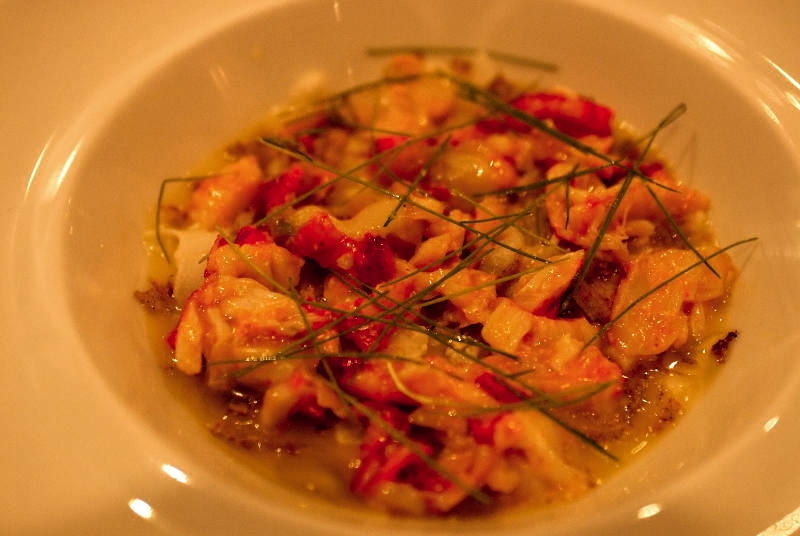
The lobster is firm but not rubbery. It yields a very satisfactory bite. The balance and interplay between the lobster, the vegetables and the starch is beyond belief. The seasoning has a tremendous impact in this alchemy:
Dauro de l’Emporda is a complex, multi-dimensional oil that can greatly enhance vegetables and this is exactly what happens, especially with the artichokes. It also has an aspect that reminds of the crust of a rustic farm-bread. That dimension of the oil is in a grounding accord with the crêpe. One additional characteristic of this oil is its elegant bitter finish that lingers on the palate quite a moment. This bitter note, which is much more subtle, for instance, than that of the well-known Tuscan variety, relates to the analogous characteristic of the Miel d’Arbousier, the much prized opaque honey of strawberry tree blossoms from the Mediterranean.
That honey, in turn, is what marries the oil to the Menton lemon. These lemons are another produce France is proud of. They are very fragrant and their acidity is softer, their tartness milder, but not to the extent that they almost turn into a different species as would be the case with hybrids such as Meyer lemons.
Permeated with tender juices of these lemons, further softened and enhanced with additional depth by the honey, the artichoke and cauliflower slices become malleable, however they keep their vivacious snap. Joy upon joy.
Our bottle of Les Chaillées de l’Enfer 2004 from George Vernay is both melodiously adorable on its own and in consonance with the multiple nuances of the lobster salad. It also works more than acceptably with the smaller dishes scattered around the main plate:
A thin pressée of tourteau has enough staying power as to be able to handle an “unsweet” crème chibouste, a light olive oil, a good amount of powdered green curry and chives. Not revelatory, but likeable.
A crab bisque, full of flavor and poise, is served with a lemon puree beautifully augmented by bergamot. That would be the only warm dish in this service.
A spiced olive oil is offered as a condiment and enjoyable as a dip for the bread every now and then.
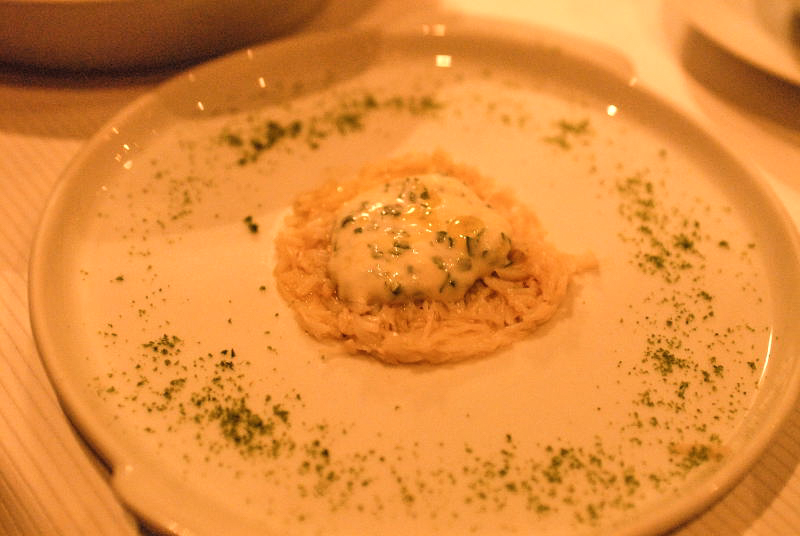
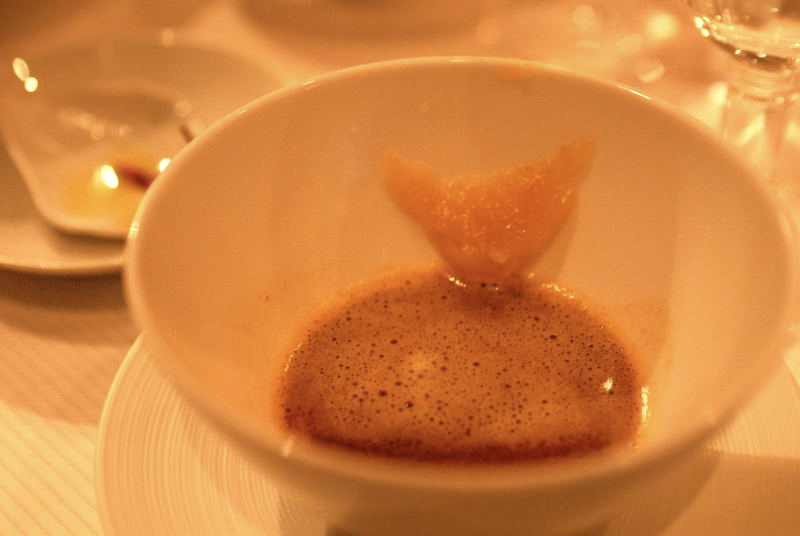
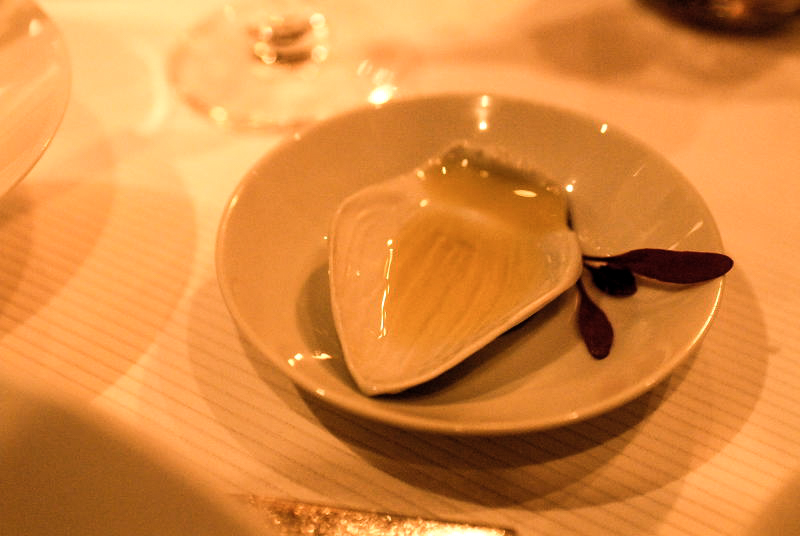
On the other hand, the prettiest of the secondary dishes hides a small disaster behind the surface. The “vegetal basket for spider crab” does not belong to a table of such sophistication:
The basket is made of seaweed. A kind that is similar to those “knots” sold in Asian markets. It is so tasteless I suspect the culprit may be a Hervé This exercise gone awry. They tell me it is not.
The treatment of spider crab is very sloppy. Watery and insipid, the meat is further spoiled by the excess of a lemon cream at the bottom of the basket.
During the service it is mentioned that the olive oil in it was from Liguria. A good, small production Ligurian olive oil is one of the best tasting experiences one can have in life. It works especially well with delicate seafood such as spider crabs. This subtle, fragrant oil is layered with complexity even though it comes only from a single variety of olives. It is also an excellent companion to lemon. But here, it is utterly unrecognizable.
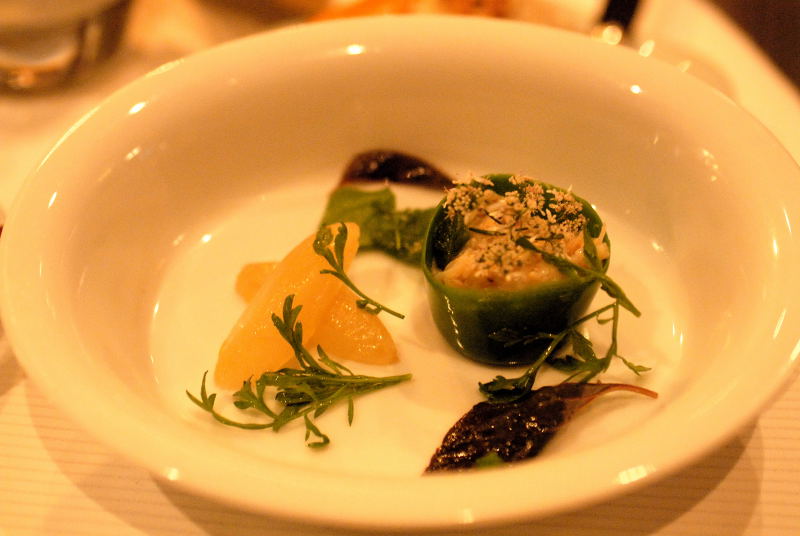
Fortunately there is plenty of the delicious wine, bread and oil dip left to erase all this and some more lobster salad to concentrate back on pleasure. Not only that, but there is also an additional delight at the end of the course:
Placed right at the top of the main plate is half a lemon “roasted” in papillote yielding an unadulterated result. It is then frosted and served with some blood orange sorbet and a big dollop of solidified olive oil. Even though the lemon stays very cold until we get to it, it is hard to tell what was holding the olive oil that tight, all that time. It melts as soon as it is inside the mouth. Whatever stabilizer there might be in it, it is very imperceptible. The sweet lemon itself has a thrilling density both in the skin and in the core. I eat it all. I am the only one who shows this barbaric manner at the table. Although I suffer the nervous gaze of my wife and daughter while doing it, I think this is worth the humiliation.
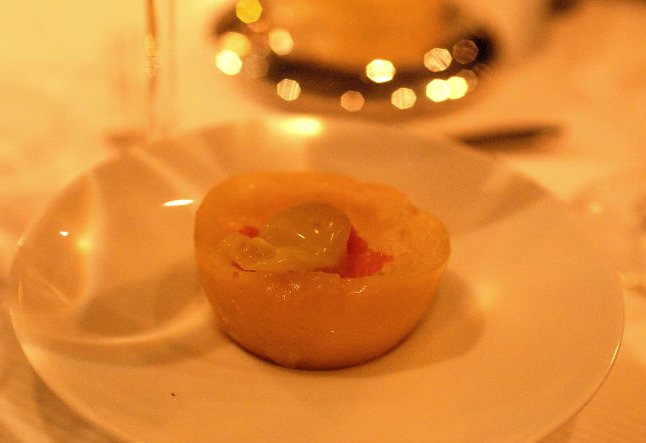
Second Course:
A dazzling and opulent preparation for the turbot.
As a large, luminous tray of filets, enshrouded with big bay leaves on their branches, solemnly carried from the kitchen to the service table like crown jewels, a flamboyant plate is placed before each of us.
These are covered by the thinnest, elongated slices of golden crisp potatoes that let four equally fragile, crisped green strands of spring onions to be seen through. Enticing aromas escaping from beneath are hinting to a veiled treasure under the protection of this commanding shield reminiscent of a heraldic sun.
Lofty claims indeed! How will the dish measure up to them?
There is a blemish, thought, to all this exquisite pageantry. One of filets is a less appealing, disproportionately wider and flatter cut. An unfortunate irritation for the table, this is unbecoming and sadly diminishing.
I should also mention rather quickly, then forget, the side dish on the right of the plate: Next to a tasty and elegantly presented ice cream of leek white is an unpleasant, green flan of leek and black truffles. It looks like cafeteria food, lacks any gustatory interest and is full of tasteless specks of truffle, left over from the last season and kept sous-vide since. Such a lapse. (Maybe this is a punishment for me because I am taking pictures, an act which I find offensive myself).
On the left of the plate is a small potato from the Channel island of Guernesay in its skin, oven baked and stuffed with a fondant of leeks and topped with a pearl colored leek foam. This will be a very sober and satisfying earthy companion to the main dish.
Except that it is abandoned and you may not hark; it is betrayed and you may not know.
How handsomely leeks can be paired with truffles is well proven. I am thinking of another French Master and his luminous “poireaux en demi deuil” fired up by a superlative salt. We are not witnessing an equipollent feat in the flan (which I should, I said, quickly forget). Yet there was an inspiring proposal:
Leeks are cocooned in a potato, on one side, and enveloping earthy par excellence truffles, on the other. An airy, volatile foam is set against the dense, stable form its essence takes in the ice cream. Realities warped by an unseen, playful hand. Not to be this time.
What I called sober is, in truth, forsaken.
Even if you will not be likely to forget that potato and its leeks for years…
The turbot is cooked on the bone before the fillet is lifted to a bed of bay leaves to be finished under the salamander resulting in admirable aromas and a well-measured caramelisation. It is gently set over the potatoes that bend under the weight without surrendering their integrity.
Then, a magnificent beurre blanc sauce is spooned over the fillet. The saucière is left on the table in a decadent, old-fashioned, nostalgic gesture that calls for a sympathetic pause.
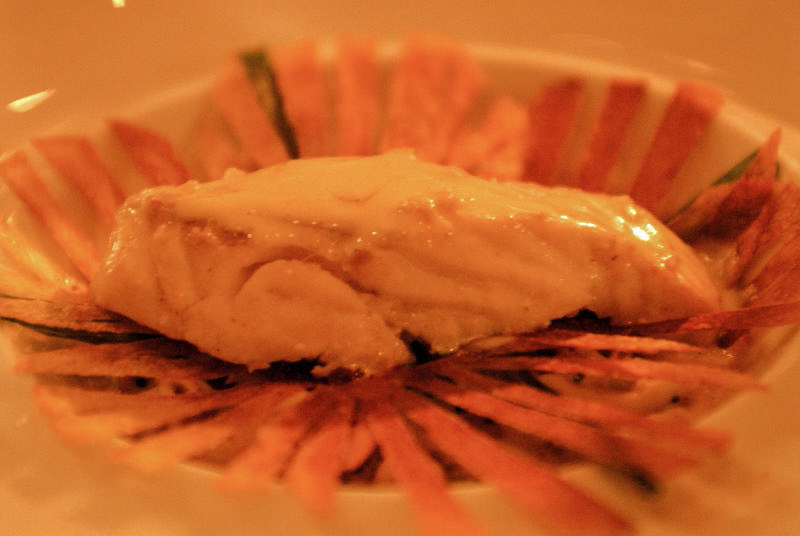
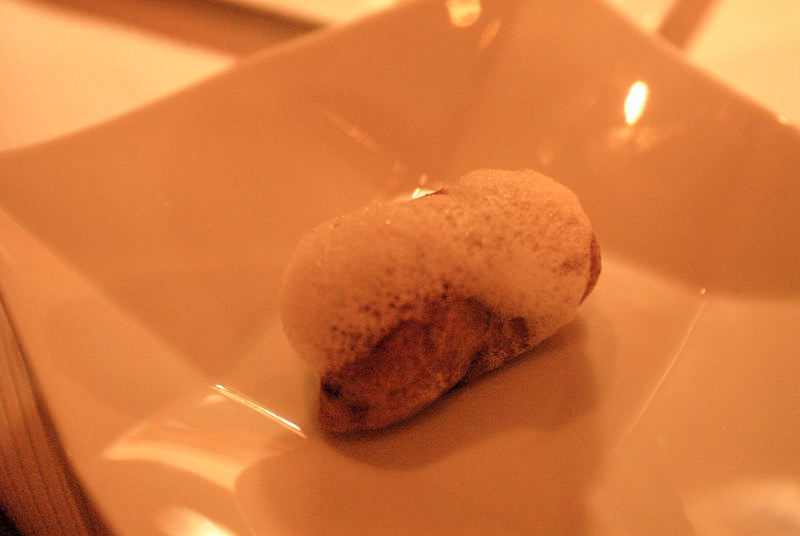
The hidden treasure under the potatoes is a matelote of baby cuttlefish and baby calamari that are covered by an unctuous sauce rivaling the creamy beurre blanc on top. It is hard to tell which is which, but possibly the bodies are from the calamari because they are so soft, and, heads and tentacles from the cuttlefish because they are rather compact.
And yes, there is not a trace of toughness in the body pieces. Beyond this, very critically, they convey a delicious gelatinous sensation also highlighted by their sauce. This experience comes so close to sucking the bones of a fatty turbot that it is exhilarating. Furthermore now, by some magic, those imaginary bones soften all of a sudden and become edible in their entirety.
The gentle crunch from the heads and tentacles, and their more apparent iodine flavor are in heavenly contrast with tender and nuttier body morsels.
There is more! Clearly, this turbot was not one of the Black Sea species with their distinctive buttons on the skin which are a bliss to slide your teeth over, almost crack but not quite, and suck. But a strange feeling is channeled through the crunch of the head and tentacles against the teeth and the tongue which is so evocative of those buttons. Moreover, ravishingly and by some enchantment, they can be eaten completely. (Or was this an imaginary favor pulled out of thin air?).
Under the absolute potentate of a Grand Chef, this dish, in which nothing is left untransformed, uncontrolled, untamed, disobedient or in excess, is a masterpiece.
So glad we have a wine that does not crush, crumble and burn when challenged with such a powerful presence: Clos de Mon Plaisir – Tesson 2002 from Guy Roulot.
Cheese:
Warm cheese course is a croque-monsieur of San Daniel and some excellent Gruyère. It is sprinkled with peeled fresh peas and févettes and accompanied by a side dish of apple dressed with half a lobe of walnut. It is served with a shot glass of walnut scented Macvin. Glorious.
Charming to have these fromages cuisinés on the menu. Obviously Gagnaire cannot endure the idea of serving the cheese the way it is delivered by the affineur. You wonder how he can bear offering the wine the way it comes out of the bottle.
Well, you do not wonder that long: a most marvelous gelée of Macvin is concealed at the bottom of the glass but it was so pristine you did not notice it until that moment. Ecstatic.
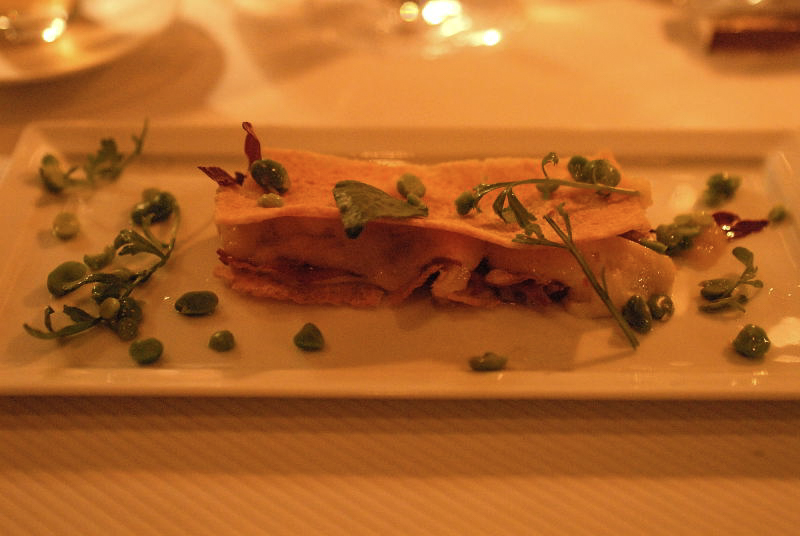
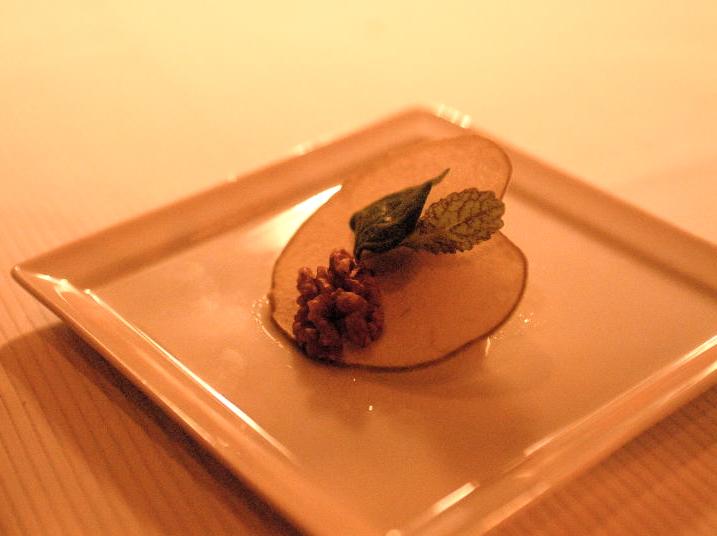
Dessert:
There is not much controversy around Gagnaire’s lavish Grand Dessert. They are refreshingly fruity, including when it is about cucumbers in a delicious mojito! Graceful with chocolate, caramel and pralinée, very moderate on the use of sugar, exuberantly presented in profusion all at once, they almost always please the patrons. Our experience is no exception.
And The Chef:
Gagnaire appears on the service way once in a while during the evening and glances over and across with inquiring eyes.
Later he comes out to tour the dining room. He greets every table scrupulously yet non-intrusively. Far from donning an attitude thirsty of accolades he moves slowly in his whites, somewhat tired. With a pensive smile. Almost melancholic.
Heartbreaking
